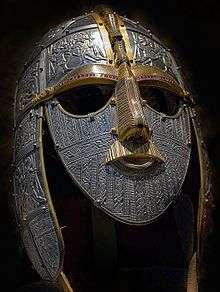Coinage in Anglo-Saxon England
| This article is part of the series: |
| Anglo-Saxon Society and Culture |
|---|
 |
| People |
| Language |
| Material culture |
| Power and organization |
| Religion |
Coinage in Anglo-Saxon England refers to the use of coins, either for monetary value or for other purposes, in Anglo-Saxon England during the early Medieval period.
Archaeologists have uncovered large quantities of coins dating to the Anglo-Saxon period, either from hoards or stray finds, making them one of the most plentiful kinds of artefact that survive from this period. Anglo-Saxonist M.A.S. Blackburn noted that they provide "a valuable source of evidence for economic, administrative and political history."[1]
History
5th to 7th centuries
Early in the 5th century CE, when Britannia, broadly comprising what is now England and Wales, ceased to be a province of the Roman Empire, the production of coinage effectively came to an end and a non-monetary economy developed. During the 5th century, Anglo-Saxon tribal groups from continental Europe migrated to central and southern Britain, introducing their own language, polytheistic religion and culture. Although gold coins from continental Europe were traded into Anglo-Saxon England, they were initially used for decorative purposes, only beginning to be used as money in the latter part of the 6th century.[2]
It was around this time that the first Anglo-Saxon coins were produced, although sustained production would not appear until the 630s. These were small, gold coins, called scillingas (shillings) in surviving Anglo-Saxon law codes, although they have since been referred to as thrymsas by numismatists. Modelled on coins produced at the same time in Merovingian Francia – geographically the rough equivalent of modern France – these early Anglo-Saxon gold shillings were often inscribed with words borrowed from either Merovingian or Roman coinage, although examples have been found which instead bear such names as those of King Eadbald of Kent, the moneyers Witmen and Pada, or the names of mints in London and Canterbury.[3] Small, thick, silver coins known as sceattas were also produced in England, as well as in Germanic continental areas of the North Sea coast, from about 680 to 750, bearing designs which featured a wide range of iconography.
In about 675 the gold shilling was superseded by the silver pening, or penny, amongst the Anglo-Saxons, and this would remain the principal English monetary denomination until the mid-14th century, during the Late Medieval period. Early silver pennies were typically decorated with geometric or pictoral designs, occasionally having the name of the moneyer inscribed on them. More rarely, coins produced in the kingdoms of Northumbria and East Anglia bore the names of monarchs.[4]
8th to 11th centuries

In the latter part of the 8th century a new style of silver penny appeared in Anglo-Saxon England, thinner and commonly bearing the names of both the king and the moneyer who had struck it. This new type of penny was apparently first introduced in the reign of the Mercian King Offa in about 760.[5]
From the 9th century, monarchs and their governments gained greater power over the control of coin production, and the designs used by different moneyers became standardised. In the 860s, the Anglo-Saxon kingdoms of Mercia and Wessex formed a monetary alliance by which coinage of a common design could circulate through both of their lands.[6]
References
Footnotes
- ↑ Blackburn 1999. p. 113.
- ↑ Blackburn 1999. p. 113.
- ↑ Blackburn 1999. p. 113.
- ↑ Blackburn 1999. p. 113.
- ↑ Blackburn 1999. p. 113.
- ↑ Blackburn 1999. p. 113.
Bibliography
- Blackburn, M.A.S. (1999). "Coinage". The Blackwell Encyclopaedia of Anglo-Saxon England (Eds: Michael Lapidge, John Blair, Simon Keynes and Donald Scragg). Oxford: Blackwell. pp. 113–116.
Further reading
- Naismith, Rory (2011). Money and Power in Anglo-Saxon England: The Southern English Kingdoms, 757–865. Cambridge University Press. ISBN 9781107006621.